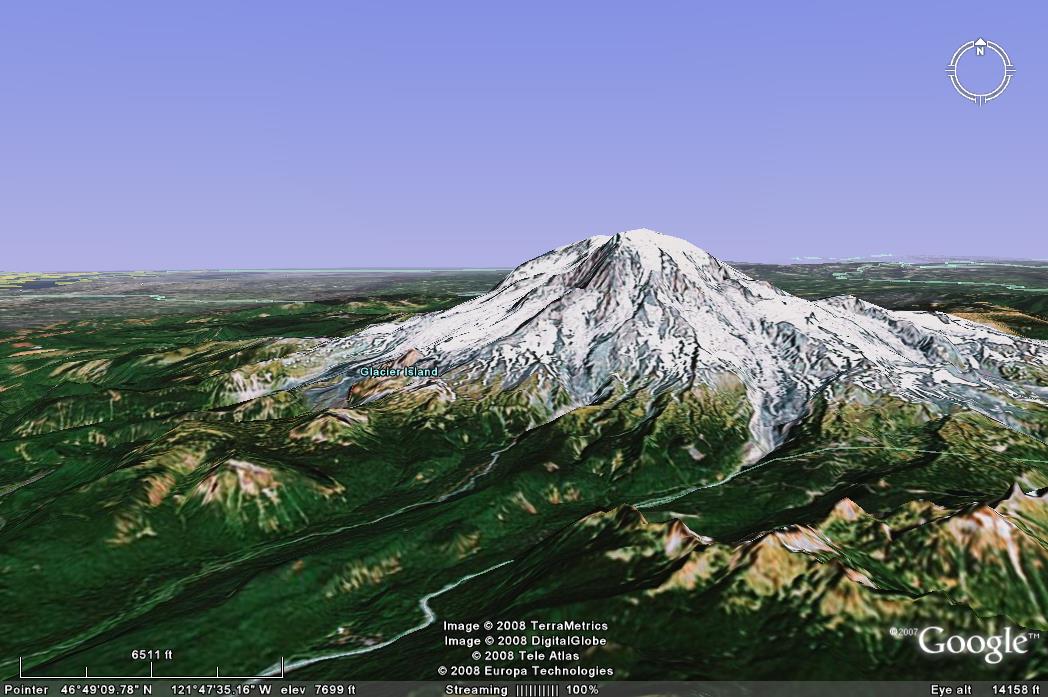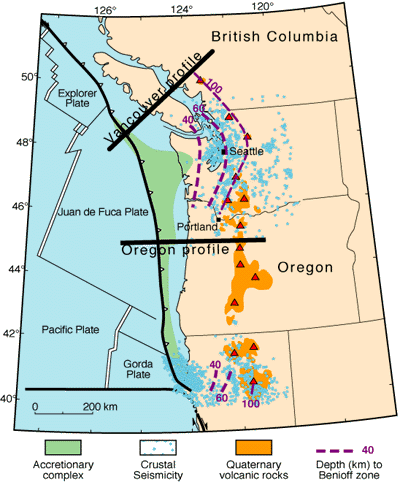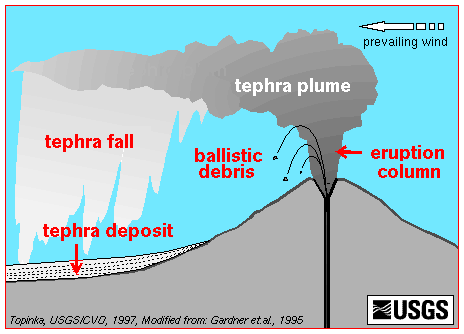|
Location, Location,
Location
Latitude: 46.853°N
Longitude: 121.760°W
x

Mt. Rainier sits 54 miles
south east of Seattle, Washington. It dominates over the
Cascade Range by "nearly 3 miles higher than the
lowlands to the west and 1.5 miles higher than the
surrounding mountains"
IV.
This gives the illusion that Rainier floats on top of
the Cascades.
 3. 3.
Tectonic Setting
The Juan De Fuca
plate is currently being subducted under the North
American Plate. In other words, the Juan de Fuca plate
is being 'dragged under' the North American plate due to
the weight of the already subducted crust. As the plate
descends into the mantle, it releases water trapped
within due to the intense pressure. This in turn lowers
the melting temperature of rocks and magma rises up
towards the crust and the surface. This area of rising
magma has created the coastal mountain range: the
Cascades.
4.

This type of tectonic
setting creates stratovolcanoes along a volcanic arc.
These are tall conic volcanoes which have been created
by layers of lava, ash and tephra. Due to the nature of
subduction zones, the magma that has been melted from
the mantle must rise through the continental crust. This
rising magma melts the continental crust, which is
silica rich and therefore produces viscous lava and
ultimately an explosive eruption. This is further
intensified by the fact that most stratovolcanoes have
magma chambers allowing for crystallization and
therefore a more crystal and silica rich viscous magma.
5..
Crystallization
Surrounding rock may
prevent magma from rising; it will then accumulate in a
magma chamber. As the magma sits, it will separate based
on density and start cooling. This cooling process will
cause some of the minerals to 'crystallize out'.
Subsequently, the magma will become more silica rich,
and will start releasing gas. This gas will increase the
pressure and may cause breakage to the surrounding rocks
forcing a path to the surface resulting in an eruption.
At this stage, the magma has been building a huge amount
of pressure and become extremely viscous; therefore, any
explosion produced in this method will be violent.
Explosions
The sorts of
eruptions that Mt. Rainier will produce are Plinian.
These are characterized by their "dark columns of tephra
and gas"I.
They are often the most
devastating volcanoes and their effects can be far
reaching. Ash and tephra can lie meters thick after an
eruption. Due to the explosively of the event, an
eruptive column can reach as high as 45km
II,
which with strong winds can reach hundreds of miles
downwind of the vent. During the 1883 Krakatoa eruption,
the explosion was so powerful and the column so high
that ash deposits made it around the world and altered
the earth's climate for many months
III. 6
6
Therefore, one of the
hazards that one should be aware of for an explosive
volcano like Mt. Rainier is the fall out and its
potential hazards (see the hazard map section for more
details). Very little molten lava is produced in these
eruptions as most is emitted as ash and tephra. However,
these volcanoes tend to partake in 'dome building' where
lava will be so viscous that it will create a plug in
the conduit and form a dome, which can grow meters in
height. |